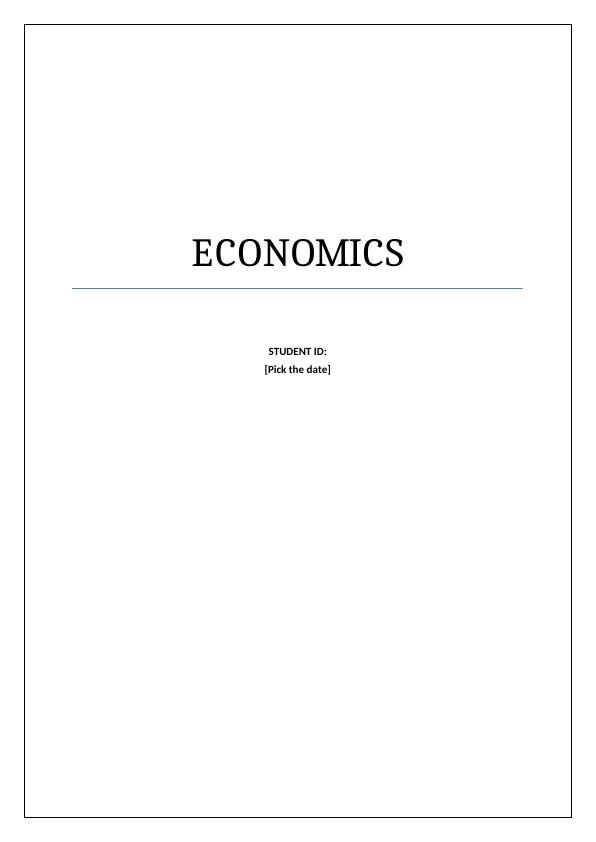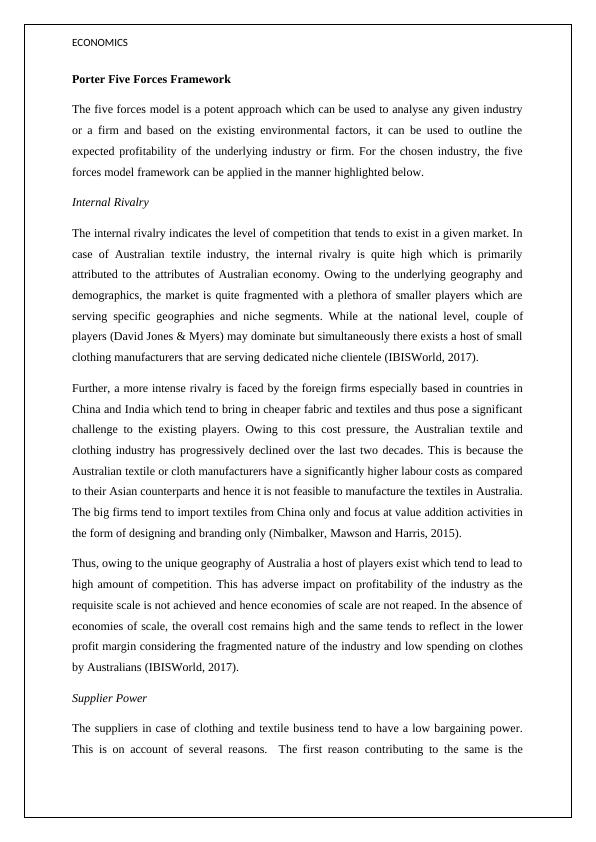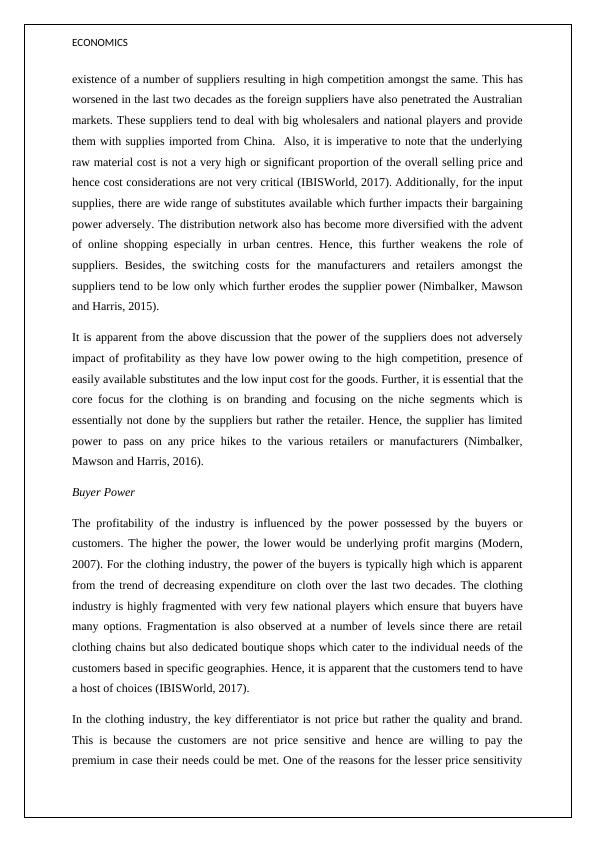Economics Assignment - Porter Five Forces Framework
6 Pages1788 Words164 Views
Added on 2020-03-16
Economics Assignment - Porter Five Forces Framework
Added on 2020-03-16
ShareRelated Documents
ECONOMICSSTUDENT ID:[Pick the date]

ECONOMICSPorter Five Forces FrameworkThe five forces model is a potent approach which can be used to analyse any given industryor a firm and based on the existing environmental factors, it can be used to outline theexpected profitability of the underlying industry or firm. For the chosen industry, the fiveforces model framework can be applied in the manner highlighted below.Internal RivalryThe internal rivalry indicates the level of competition that tends to exist in a given market. Incase of Australian textile industry, the internal rivalry is quite high which is primarilyattributed to the attributes of Australian economy. Owing to the underlying geography anddemographics, the market is quite fragmented with a plethora of smaller players which areserving specific geographies and niche segments. While at the national level, couple ofplayers (David Jones & Myers) may dominate but simultaneously there exists a host of smallclothing manufacturers that are serving dedicated niche clientele (IBISWorld, 2017).Further, a more intense rivalry is faced by the foreign firms especially based in countries inChina and India which tend to bring in cheaper fabric and textiles and thus pose a significantchallenge to the existing players. Owing to this cost pressure, the Australian textile andclothing industry has progressively declined over the last two decades. This is because theAustralian textile or cloth manufacturers have a significantly higher labour costs as comparedto their Asian counterparts and hence it is not feasible to manufacture the textiles in Australia.The big firms tend to import textiles from China only and focus at value addition activities inthe form of designing and branding only (Nimbalker, Mawson and Harris, 2015).Thus, owing to the unique geography of Australia a host of players exist which tend to lead tohigh amount of competition. This has adverse impact on profitability of the industry as therequisite scale is not achieved and hence economies of scale are not reaped. In the absence ofeconomies of scale, the overall cost remains high and the same tends to reflect in the lowerprofit margin considering the fragmented nature of the industry and low spending on clothesby Australians (IBISWorld, 2017).Supplier PowerThe suppliers in case of clothing and textile business tend to have a low bargaining power.This is on account of several reasons. The first reason contributing to the same is the

ECONOMICSexistence of a number of suppliers resulting in high competition amongst the same. This hasworsened in the last two decades as the foreign suppliers have also penetrated the Australianmarkets. These suppliers tend to deal with big wholesalers and national players and providethem with supplies imported from China. Also, it is imperative to note that the underlyingraw material cost is not a very high or significant proportion of the overall selling price andhence cost considerations are not very critical (IBISWorld, 2017). Additionally, for the inputsupplies, there are wide range of substitutes available which further impacts their bargainingpower adversely. The distribution network also has become more diversified with the adventof online shopping especially in urban centres. Hence, this further weakens the role ofsuppliers. Besides, the switching costs for the manufacturers and retailers amongst thesuppliers tend to be low only which further erodes the supplier power (Nimbalker, Mawsonand Harris, 2015).It is apparent from the above discussion that the power of the suppliers does not adverselyimpact of profitability as they have low power owing to the high competition, presence ofeasily available substitutes and the low input cost for the goods. Further, it is essential that thecore focus for the clothing is on branding and focusing on the niche segments which isessentially not done by the suppliers but rather the retailer. Hence, the supplier has limitedpower to pass on any price hikes to the various retailers or manufacturers (Nimbalker,Mawson and Harris, 2016).Buyer PowerThe profitability of the industry is influenced by the power possessed by the buyers orcustomers. The higher the power, the lower would be underlying profit margins (Modern,2007). For the clothing industry, the power of the buyers is typically high which is apparentfrom the trend of decreasing expenditure on cloth over the last two decades. The clothingindustry is highly fragmented with very few national players which ensure that buyers havemany options. Fragmentation is also observed at a number of levels since there are retailclothing chains but also dedicated boutique shops which cater to the individual needs of thecustomers based in specific geographies. Hence, it is apparent that the customers tend to havea host of choices (IBISWorld, 2017).In the clothing industry, the key differentiator is not price but rather the quality and brand.This is because the customers are not price sensitive and hence are willing to pay thepremium in case their needs could be met. One of the reasons for the lesser price sensitivity

End of preview
Want to access all the pages? Upload your documents or become a member.
Related Documents
Construction in the United Kingdomlg...
|37
|13332
|450
Industry Analysis: Porter's Five Model, Ansoff's Matrix and Blue Ocean Strategylg...
|8
|2470
|246
Industry Analysis and Possible Adaptations - Assignmentlg...
|13
|3751
|473
Porters Five Forces to international streaming marketlg...
|6
|544
|391
Woolworths International Marketing Plan Assignmentlg...
|5
|808
|172
Competitive Strategy: Porter Five Forces, SWOT, PESTLE Analysislg...
|10
|1611
|301
